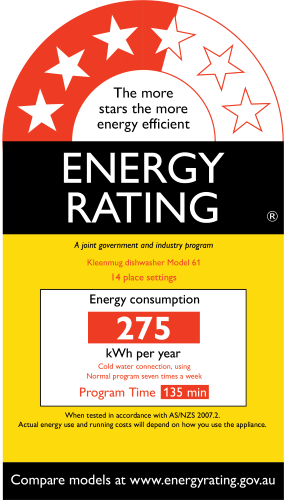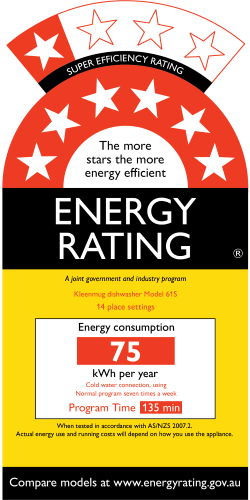For Industry
Dishwashers

Overview
Dishwashers have become a modern convenience that many households cannot live without. They can save time, but consume electricity and water, adding to household bills. The Energy Rating Label helps consumers make informed choices by allowing them to compare energy efficiency and running costs across different models.
At a Glance
To fully understand legislative requirements, registrants should review the 2024 determination and its Explanatory Statement. They can be accessed from the Federal Registration of Legislation using the link in the table below.
| Determination | Minimum Energy Performance Standards | Energy Rating Label |
|---|---|---|
|
Greenhouse and Energy Minimum Standards (Dishwashers) Determination 2024 Commenced 4 October 2025 |
Yes | Yes |
The determination:
- creates minimum energy performance standards for dishwashers
- updates testing and labelling requirements
- introduces new Australian and New Zealand standards.
Suppliers can continue to sell existing registered models. These requirements take effect when a model needs to be registered for sale in Australia.
Legislation
In Australia, this product is regulated under the Greenhouse and Energy Minimum Standards Act 2012.
In New Zealand, the relevant legislation is the Energy Efficiency (Energy Using Products) Regulations 2002. New Zealand has different requirements. Visit Dishwashers on the Energy Efficiency and Conservation Authority website for more information.
What products are covered?
Products covered by the determination include electric household dishwashers that have a rated capacity of one place setting or more, irrespective of the context in which they are used.
Refer to section 7 of the determination for more details.
Technical requirements
-
Standards
The determination references:
- AS/NZS 2007.1:2021 Performance of household electrical appliances - Dishwashers, Part 1: Methods for measuring performance, energy and water consumption
- AS/NZS 2007.2:2021 Performance of household electrical appliances - Dishwashers, Part 2: Energy efficiency labelling requirements
The version of the standards that apply are the versions, including amendments, that existed when the determination came into force.
-
Minimum Standards
The determination creates minimum energy performance standards (MEPS), specified in section 8 of the determination.
The MEPS are not expected to result in any model being forced from the market.
-
Testing your product
Make sure you match the test report with the registration application you make.
The determination requires dishwashers to be tested in accordance with AS/NZS 2007.1:2021 Performance of household electrical appliances – Dishwashers, Part 1: Methods for measuring performance, energy and water consumption.
In some cases, a test report to the earlier version of the standard could be used as evidence of testing. Test reports to AS/NZS 2007.1:2005 could be accepted if all requirements are met and the testing:
- was conducted at a supply test voltage of 230V
- used International Electrotechnical Commission (IEC) test load items
- for multi-compartment dishwashers, the test report could only be used if:
- the multiple compartments can only be operated together, or
- where the compartments can be operated independently, separate testing was conducted for each compartment to allow energy labelling calculations to be performed for each compartment.
-
Other
Dishwashers must also meet the performance requirements mentioned in Section 3.2 of AS/NZS 2007.2:2021 (rated capacity), Section 3.3 of AS/NZS 2007.2:2021 (washing index) and Section 3.5 of AS/NZS 2007.2:2021 (drying index).
Labelling requirements
The Energy Rating Label has changed and you must display the new:
- base Energy Rating Label is used for models that meet 6 or below star ratings in half star rating increments
- super efficiency Energy Rating Label is used for models that meet 7 or above star ratings in full star rating increments.
The determination incorporates information on the Energy Rating Label and how the label is displayed.
Labelling transition
Models that were previously registered against the old 2015 determination can apply transitional arrangements to labelling for the remainder of the registration period. This means that some models may display either the new or the old label. Only one label should be displayed on any one product.
If a model is selected for check testing, the laboratory will test the product to the standards quoted on the energy rating label affixed to the purchased product. Market Surveillance will continue to check that the label on the product matches the registration record, and that the product is correctly registered.
Program Time
Energy Rating Labels for dishwashers must include ‘Program Time’, which is the time the product requires to complete the program used to measure its energy performance.

Displaying the Label
Products on display must include a label on the packaging, or if it is displayed outside the packaging, it should be applied on the model.
In each case, the Energy Rating Label must be clearly visible either printed on, adhered to, or be part of the packaging. If adhered to the packaging, then it can be attached by a double-sided swing tag or non-rotating single sided swing tag.

Need more help?
More information about the labelling requirements can be found in the standard Performance of household electrical appliances - Dishwashers, Part 2: Energy efficiency labelling requirements–AS/NZS 2007.2:2021.
See Labelling for general labelling information and resources.
Models registered to the 2015 determination
Existing registrations have been updated in the Energy Rating Registration system to be registered against the 2024 determination. Registrants don’t need to do anything, and the registration will retain its remaining period of registration.

